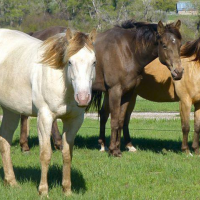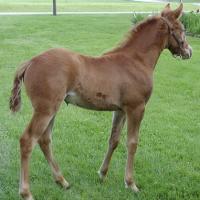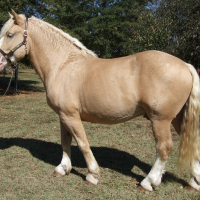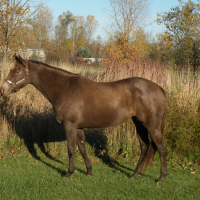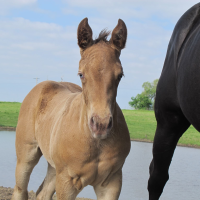Pictorial Guide to Horse Colors Part 4
This guide is written to help identify horse colors. It does not explain the genetics behind the colors. If you would like to know more about the genetics of these colors please visit Dilutions in horses. If you would like to view more examples of Champagne horse please visit the Champagne Gallery.
Like Dun, Champagne horses have certain characteristics that can be used to identify them as Champagne. This are light eyes (usually amber), pink skin that is mottled or freckled, and a diluted body color. When identifying Champagne horses all three of these characteristics must be present. Light eyes, speckled skin, or dilute body color (even two out of three) can be present in a horse who is not Champagne. From a distance and in photographs an adult champagne’s skin can have a purple tint. This is actually the result of mottling or freckling which can be seen when viewed close-up. Some, Champagnes may have so much freckling on their nose that it can appear solid (but will still be lighter colored than a non-champagne horse). In these horses it can be necessary to look at skin that has not been exposed to sunlight ie under the tail or between the rear legs. Champagnes often have a “sheen” to their coats that is not present in other coat colors. This can give them a metallic appearance when in sunlight. Champagne horses are also more prone to reverse dapples than horses of other colors. Although the shining coat and reverse dapples are often related to champagne they should not be used to identify Champagne. Reverse dapples and a metallic sheen hey can occur in non-champagne horses and are there are many Champagnes without them. Champagne foals are born darker than their final adult color and have blue eyes and bright pink skin. The eyes and skin gradually darken with the eyes shifting over several months from blue to green and finally to amber and the skin darkening slightly and freckling.

Champagne skin and eye characteristics. Note the amber eyes and freckled skin. The amount of freckling can vary.
Gold Champagne
Gold Champagne horses can vary in coloration from a horse that closely resembles a palomino, including a white mane and tail and light gold body, to a horse whose body is deep gold with a mane and tail is the same color as it’s body. These dark Gold Champagnes are sometimes referred to as “self” Champagne. Although a Gold Champagnes mane, tail, and lower legs can be as dark or slightly darker than their body color they should never be brown or dark tan.
Amber Champagne
Amber Champagne horses will have a body color similar to a piece of amber with some variation. They usually have a brown or dark tan points and similarly colored mane and tail however, some very light Amber Champagnes may have lower legs that are the same color as their body. Amber champagnes should always have at least some darker coloration in the mane and/or tail unless white markings obscure them.

A very light Amber Champagne. Notice that the lower legs and mane are almost the same color as the body although the tail is still slightly darker.
Sable Champagne
Sable Champagne horses can be difficult to distinguish from Amber Champagnes and in most cases a separate classification is not needed. Sables Champagnes will have a darker body color than Amber Champagnes and will often be born with countershaded primitive markings. At times Sable Champagnes foals will fool even seasoned horse people into thinking their horse also carries dun when this is not the case. The Sable Champagnes that are easiest to identify will resemble classic champagnes with lighter noses and flanks.
Classic Champagne
Classic Champagne horses are generally the darkest of the Champagne colors, although some sables can be just as dark. The body color will be uniform or near uniform and will generally be the color of coffee with cream. Points can be the same color as the body but are often slightly darker. The mane and tail are usually a shade darker than the body.

